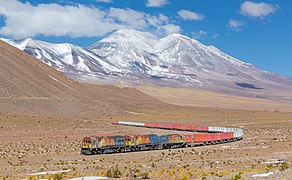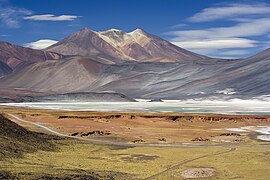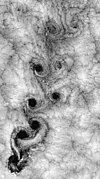Portal:Chile
| Main page | Assessment | Articles | Templates | Translation | Noticeboard | To Do List | Portal |
The Chile Portal

Chile, officially the Republic of Chile, is a country in western South America. It is the southernmost country in the world and the closest to Antarctica, stretching along a narrow strip of land between the Andes Mountains and the Pacific Ocean. Chile had a population of 17.5 million as of the latest census in 2017 and has a territorial area of 756,102 square kilometers (291,933 sq mi), sharing borders with Peru to the north, Bolivia to the northeast, Argentina to the east, and the Drake Passage to the south. The country also controls several Pacific islands, including Juan Fernández, Isla Salas y Gómez, Desventuradas, and Easter Island, and claims about 1,250,000 square kilometers (480,000 sq mi) of Antarctica as the Chilean Antarctic Territory. The capital and largest city of Chile is Santiago, and the national language is Spanish.
Spain conquered and colonized the region in the mid-16th century, replacing Inca rule, but failed to conquer the independent Mapuche people who inhabited what is now south-central Chile. Chile emerged as a relatively stable authoritarian republic in the 1830s after their 1818 declaration of independence from Spain. During the 19th century, Chile experienced significant economic and territorial growth, putting an end to Mapuche resistance in the 1880s and gaining its current northern territory in the War of the Pacific (1879–83) by defeating Peru and Bolivia. In the 20th century, up until the 1970s, Chile underwent a process of democratization and experienced rapid population growth and urbanization, while relying increasingly on exports from copper mining to support its economy. During the 1960s and 1970s, the country was marked by severe left-right political polarization and turmoil, which culminated in the 1973 Chilean coup d'état that overthrew Salvador Allende's democratically elected left-wing government. This was followed by a 16-year right-wing military dictatorship under Augusto Pinochet, which resulted in more than 3,000 deaths or disappearances. The regime ended in 1990, following a referendum in 1988, and was succeeded by a center-left coalition, which ruled until 2010.
Chile has a high-income economy and is one of the most economically and socially stable nations in South America, leading Latin America in competitiveness, per capita income, globalization, peace, and economic freedom. Chile also performs well in the region in terms of sustainability of the state and democratic development, and boasts the second lowest homicide rate in the Americas, following only Canada. Chile is a founding member of the United Nations, the Community of Latin American and Caribbean States (CELAC), and the Pacific Alliance, and joined the OECD in 2010. (Full article...)
The 2010 Pichilemu earthquakes (Spanish: Terremoto de Pichilemu de 2010), also known as the Libertador O'Higgins earthquakes, were a pair of intraplate earthquakes measuring 6.9 and 7.0 Mw that struck Chile's O'Higgins Region on 11 March 2010 about 16 minutes apart. The earthquakes were centred 15 kilometres (9.3 mi) northwest of the city of Pichilemu.
The earthquakes were caused by increased regional stress arising from an earthquake on 27 February, centered offshore Maule Region, which was felt throughout central Chile. The Hawaii-based Pacific Tsunami Warning Center pointed out the possibility of local tsunamis within 100 kilometres (62 mi) of the epicentre, although small, but violent waves were seen in the Pichilemu and Bucalemu area. One person was reported dead. At least eleven aftershocks immediately followed, causing panic throughout coastal towns between the Coquimbo and Los Lagos regions. (Full article...)Selected biography -
Pablo Neruda (/nəˈruːdə/ nə-ROO-də; Spanish pronunciation: [ˈpaβlo neˈɾuða] ; born Ricardo Eliécer Neftalí Reyes Basoalto; 12 July 1904 – 23 September 1973) was a Chilean poet-diplomat and politician who won the 1971 Nobel Prize in Literature. Neruda became known as a poet when he was 13 years old and wrote in a variety of styles, including surrealist poems, historical epics, political manifestos, a prose autobiography, and passionate love poems such as the ones in his collection Twenty Love Poems and a Song of Despair (1924).
Neruda occupied many diplomatic positions in various countries during his lifetime and served a term as a senator for the Chilean Communist Party. When President Gabriel González Videla outlawed communism in Chile in 1948, a warrant was issued for Neruda's arrest. Friends hid him for months in the basement of a house in the port city of Valparaíso, and in 1949, he escaped through a mountain pass near Maihue Lake into Argentina; he would not return to Chile for more than three years. He was a close advisor to Chile's socialist president Salvador Allende, and when he got back to Chile after accepting his Nobel Prize in Stockholm, Allende invited him to read at the Estadio Nacional before 70,000 people. (Full article...)Selected article -
General images
Did you know (auto generated)

- ... that the Chile Ridge has a slab window?
- ... that Daniela Ceballos worked with the Football Federation of Chile to supervise safety protocols during the COVID-19 pandemic while playing football herself?
- ... that Angelito de Canal 13, the mascot of the Chilean television network Canal 13, was inspired by its creator's son?
- ... that the Peruvian Civil Guard officer Mariano Santos Mateo was nicknamed the Brave Man of Tarapacá because he captured a banner of a Chilean military unit during the Battle of Tarapacá?
- ... that Salar de Pedernales in Chile features dark slope streaks resembling dark slope streaks on Mars?
- ... that Salar de Pajonales in Chile has been used as an analogue for environments on Mars?
Topics
Categories
Recognized content
| This is a list of recognized content, updated weekly by JL-Bot (talk · contribs) (typically on Saturdays). There is no need to edit the list yourself. If an article is missing from the list, make sure it is tagged (e.g. {{WikiProject Chile}}) or categorized correctly and wait for the next update. See WP:RECOG for configuration options. |
Featured articles
- Chilean battleship Almirante Latorre
- Almirante Latorre-class battleship
- Cerro Azul (Chile volcano)
- Calabozos
- El Tatio
- Chilean cruiser Esmeralda (1883)
- Guallatiri
- Mount Hudson
- Laguna del Maule (volcano)
- Mothers of the Disappeared
- Ojos del Salado
- Pali-Aike volcanic field
- Pisco sour
- South American dreadnought race
- Taapaca
Good articles
- 2010 Pichilemu earthquakes
- 2018 Santiago ePrix
- Agustín Ross Cultural Centre
- Angata
- Los Ángeles Negros
- Apacheta-Aguilucho volcanic complex
- Argentine–Chilean naval arms race
- Atamu Tekena
- Orlando Bosch
- Lorenza Böttner
- Sara Braun
- Monte Burney
- Battle of Caldera Bay
- Felipe Camiroaga
- Chilean battleship Capitán Prat
- Carménère
- José María Caro Martínez
- Chile at the 2014 Winter Paralympics
- Coat of arms of Pichilemu
- Dutch expedition to Valdivia
- El Laco
- Milton Friedman
- Fueguino
- Irruputuncu
- Laguna Miscanti
- Laguna del Negro Francisco
- Lascar (volcano)
- Lastarria
- Lazufre
- Licancabur
- Licancabur Lake
- Llullaillaco
- Nevado de Longaví
- Manuel Foster Observatory
- Monturaqui
- Irene Morales
- John Thomas North
- Obligation to Negotiate Access to the Pacific Ocean
- Olca-Paruma
- USS Oneota (1864)
- La Pacana
- Parinacota (volcano)
- Patio 29
- Pichilemu
- Colegio de la Preciosa Sangre de Pichilemu
- Salar de Punta Negra
- Reclus (volcano)
- Murders of María José Reyes and Juan Duarte
- Sammis Reyes
- Riro Kāinga
- Sairecabur
- Salar Ignorado
- San Pedro (Chile volcano)
- Socompa
- Sollipulli
- Tacora
- Tilocálar
- Nevado Tres Cruces
- Tupungatito
- Tuyajto Lake
Featured pictures
-
360-degree Panorama of the Southern Sky edit
-
A 360 degree panorama of a unique cloudscape over La Silla
-
Culpeo MC
-
FCAB EMD GT22CU-3 San Pedro - Ascotan
-
Laguna Miñiques, Chile, 2016-02-08, DD 33-38 PAN
-
Laser Towards Milky Ways Centre
-
Miscanti Lagoon near San Pedro de Atacama Chile Luca Galuzzi 2006
-
Moai Rano raraku
-
SQM GE 289A Boxcab Carmelita - Reverso
-
Volcán San Pedro, Chile, 2016-02-09, DD 18
-
Vortex-street-1
WikiProjects
Related portals
New articles
Rules | Match log | Results page (for watching) | Last updated: 2024-05-24 19:56 (UTC)
Note: The list display can now be customized by each user. See List display personalization for details.
- 2019 WRC2 Championship (edit | talk | history | links | watch | logs | tools) by Rally Wonk (talk · contribs · new pages (36)) started on 2024-05-24, score: 14
- Sergio Hernán Pérez de Arce Arraigada (edit | talk | history | links | watch | logs | tools) by Ababil0811 (talk · contribs · new pages (2)) started on 2024-05-24, score: 18
- Simon of the Mountain (edit | talk | history | links | watch | logs | tools) by Οἶδα (talk · contribs · new pages (30)) started on 2024-05-24, score: 31
- Baile Funk Experience (edit | talk | history | links | watch | logs | tools) by Hyck (talk · contribs · new pages (2)) started on 2024-05-23, score: 14
- Catholic Church sexual abuse cases in Venezuela (edit | talk | history | links | watch | logs | tools) by Borboteo (talk · contribs · new pages (14)) started on 2024-05-23, score: 16
- Sixties Song (edit | talk | history | links | watch | logs | tools) by TabbyLadrona (talk · contribs · new pages (12)) started on 2024-05-22, score: 20
- David Pérez (footballer) (edit | talk | history | links | watch | logs | tools) by Das osmnezz (talk · contribs · new pages (66)) started on 2024-05-22, score: 15
- Lara Casas (edit | talk | history | links | watch | logs | tools) by Lachie23 (talk · contribs · new pages (3)) started on 2024-05-22, score: 20
- Leonora Vicuña (edit | talk | history | links | watch | logs | tools) by Nick Number (talk · contribs · new pages (19)) started on 2024-05-21, score: 63
- Matías Carrera (edit | talk | history | links | watch | logs | tools) by ImSnot (talk · contribs · new pages (9)) started on 2024-05-21, score: 23
- Atacamallium (edit | talk | history | links | watch | logs | tools) by Tom Radulovich (talk · contribs · new pages (146)) started on 2024-05-21, score: 67
- Teresa Lima (edit | talk | history | links | watch | logs | tools) by Lachie23 (talk · contribs · new pages (3)) started on 2024-05-21, score: 14
- Negationism of the military dictatorship of Chile (edit | talk | history | links | watch | logs | tools) by Borboteo (talk · contribs · new pages (14)) started on 2024-05-20, score: 43
- Dublin Declaration on Maternal Healthcare (edit | talk | history | links | watch | logs | tools) by Wikisaurus (talk · contribs · new pages (4)) started on 2024-05-20, score: 16
- Action of Rights Protection (Chile) (edit | talk | history | links | watch | logs | tools) by Xarucoponce (talk · contribs · new pages (1)) started on 2024-05-20, score: 53
- List of Academy Award–nominated films (edit | talk | history | links | watch | logs | tools) by Ostcgl (talk · contribs · new pages (1)) started on 2024-05-20, score: 16
- Patagona (edit | talk | history | links | watch | logs | tools) by UtherSRG (talk · contribs · new pages (29)) started on 2024-05-20, score: 16
- La Más Draga: Solo Las Más (edit | talk | history | links | watch | logs | tools) by Dominikcapuan (talk · contribs · new pages (1)) started on 2024-05-19, score: 14
- Gamochaeta alpina (edit | talk | history | links | watch | logs | tools) by Peter coxhead (talk · contribs · new pages (54)) started on 2024-05-19, score: 31
- Johannes Nuñez (edit | talk | history | links | watch | logs | tools) by ImSnot (talk · contribs · new pages (9)) started on 2024-05-18, score: 23
- Eunice pennata (edit | talk | history | links | watch | logs | tools) by PigeonJesus (talk · contribs · new pages (4)) started on 2024-05-18, score: 16
- History of Bologna FC 1909 (edit | talk | history | links | watch | logs | tools) by Manoru007 (talk · contribs · new pages (5)) started on 2024-05-17, score: 14
- The Idol (1952 film) (edit | talk | history | links | watch | logs | tools) by Lord Cornwallis (talk · contribs · new pages (43)) started on 2024-05-17, score: 43
- Confession at Dawn (edit | talk | history | links | watch | logs | tools) by Lord Cornwallis (talk · contribs · new pages (43)) started on 2024-05-17, score: 31
- Meganoticias (edit | talk | history | links | watch | logs | tools) by FrederickEvans (talk · contribs · new pages (22)) started on 2024-05-17, score: 43
- La torre de Mabel (edit | talk | history | links | watch | logs | tools) by FrederickEvans (talk · contribs · new pages (22)) started on 2024-05-17, score: 43
- Historic Centre of Cuzco (edit | talk | history | links | watch | logs | tools) by AlejandroFC (talk · contribs · new pages (17)) started on 2024-05-16, score: 14
- Montserrat Palmer (edit | talk | history | links | watch | logs | tools) by TomasVial (talk · contribs · new pages (2)) started on 2024-05-16, score: 49
- Marti Group (edit | talk | history | links | watch | logs | tools) by Fejesjoco (talk · contribs · new pages (1)) started on 2024-05-15, score: 16
- The Gelboys (edit | talk | history | links | watch | logs | tools) by Karich28 (talk · contribs · new pages (10)) started on 2024-05-15, score: 24
- Caroline Dawson (writer) (edit | talk | history | links | watch | logs | tools) by Bearcat (talk · contribs · new pages (140)) started on 2024-05-15, score: 35
- Carlos Díaz León (edit | talk | history | links | watch | logs | tools) by Tommy Boy (talk · contribs · new pages (1)) started on 2024-05-14, score: 43
- Astronomical Observatory University of Warsaw (edit | talk | history | links | watch | logs | tools) by Rpoleski (talk · contribs · new pages (0)) started on 2024-05-03, score: 16
- Juan Carlos Bertone (edit | talk | history | links | watch | logs | tools) by ImSnot (talk · contribs · new pages (9)) started on 2024-05-14, score: 31
- List of P1Harmony live performances (edit | talk | history | links | watch | logs | tools) by Takpods (talk · contribs · new pages (1)) started on 2024-05-14, score: 14
- Lissette García Bustamante (edit | talk | history | links | watch | logs | tools) by Old-AgedKid (talk · contribs · new pages (3)) started on 2024-05-13, score: 43
- Gastón Stang (edit | talk | history | links | watch | logs | tools) by Das osmnezz (talk · contribs · new pages (66)) started on 2024-05-13, score: 24
- Víctor Fuentes (Chilean footballer) (edit | talk | history | links | watch | logs | tools) by BrazilianDude70 (talk · contribs · new pages (37)) started on 2024-05-13, score: 63
- John Budinich (edit | talk | history | links | watch | logs | tools) by EssNS (talk · contribs · new pages (31)) started on 2024-05-12, score: 37
- Refinado Tom (edit | talk | history | links | watch | logs | tools) by TabbyLadrona (talk · contribs · new pages (12)) started on 2024-05-12, score: 16
- Juan Martínez Gutiérrez (edit | talk | history | links | watch | logs | tools) by TomasVial (talk · contribs · new pages (2)) started on 2024-05-12, score: 43
- Tomás Lerman (edit | talk | history | links | watch | logs | tools) by ImSnot (talk · contribs · new pages (9)) started on 2024-05-12, score: 35
- Pedro Areso (edit | talk | history | links | watch | logs | tools) by Barr Theo (talk · contribs · new pages (52)) started on 2024-05-11, score: 28
- José Brunetti, 15th Duke of Arcos (edit | talk | history | links | watch | logs | tools) by DACC23 (talk · contribs · new pages (25)) started on 2024-05-10, score: 16
- Damián De Hoyos (edit | talk | history | links | watch | logs | tools) by ImSnot (talk · contribs · new pages (9)) started on 2024-05-10, score: 35
- Cristian Muga (edit | talk | history | links | watch | logs | tools) by ImSnot (talk · contribs · new pages (9)) started on 2024-05-10, score: 35
- Aguairenda (edit | talk | history | links | watch | logs | tools) by TulsaPoliticsFan (talk · contribs · new pages (20)) started on 2024-05-10, score: 18
- Marisola (edit | talk | history | links | watch | logs | tools) by Sebaspikyaq (talk · contribs · new pages (13)) started on 2024-05-10, score: 31
- List of international trips made by Winston Peters as Foreign Minister (edit | talk | history | links | watch | logs | tools) by DougDommadome (talk · contribs · new pages (0)) started on 2024-05-04, score: 14
Associated Wikimedia
The following Wikimedia Foundation sister projects provide more on this subject:
-
Commons
Free media repository -
Wikibooks
Free textbooks and manuals -
Wikidata
Free knowledge base -
Wikinews
Free-content news -
Wikiquote
Collection of quotations -
Wikisource
Free-content library -
Wikiversity
Free learning tools -
Wikivoyage
Free travel guide -
Wiktionary
Dictionary and thesaurus
























































